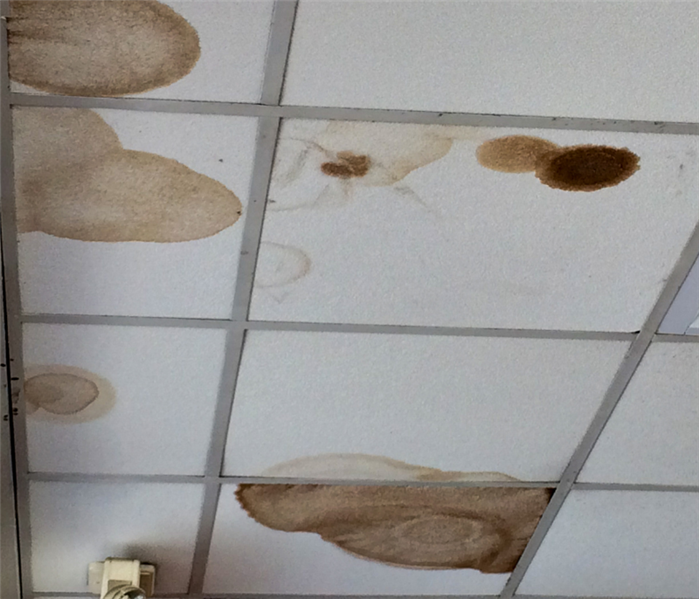How To Deal With Water Damaged Ceiling Tiles
10/1/2020 (Permalink)
As an office manager or business owner, you likely take steps to ensure your working space stays clean and professional to give the right impression when new clients or customers visit.
But, what do you do when you look up and notice large, brown, ugly water stains on your ceiling tiles? Besides from being an eyesore, water damaged ceiling tiles can begin to smell and grow mold. Here, we will review the causes of water damage to ceiling tiles and what you can do to fix them.
What Causes Water Damaged Ceiling Tiles?
Ceiling stains almost always indicate some sort of water leak in your office. These are usually tan or brown in appearance and will darken over time. When unaddressed, water damaged ceiling tiles will begin to produce mold growth as the moisture in the tiles creates an environment for mold spores and other bacteria to thrive.
Common causes of water damaged ceiling tiles include:
- Leaking HVAC components: Parts of your heating and cooling system may begin to leak overtime. If your system has not been serviced in a while and isn’t working correctly, built up moisture or condensation can also cause ceiling stains.
- Roof leaks: The water coming in from the roof may only make the ceiling stain worse after heavy rains or when snow is melting and will continue until fixed.
- Ice dams: Ice dams are common in cold areas during the winter, and essentially cause roof leaks to your office or business. As snow melts, it will leak inside and damage the ceiling tiles.
- Faulty appliances: Refrigerators, water heaters, coolers, or water lines to these appliances may fail and cause them to leak over time. When these are located on an upper level of the building, they can leak into the ceiling below and cause your discoloration.
- Leaking pipes: Old or corroded pipes may have slow leaks that can end up affecting office ceiling tiles.
- Leaking toilets or sinks: These can slowly leak over time, and you likely won’t notice until a water stain has formed on the ceiling tiles in the room below.
When you identify discoloration of ceiling tiles, you should inspect it right away to see if it is water damage. This will help ensure that you find the source of the water and can have it fixed as soon as possible. The long you wait, the more damage there will be done. In some cases, doing nothing may end with major flooding in your office or business.
Can You Save Water Damaged Ceiling Tiles?
Being able to save water damaged ceiling tiles depends on a few factors:
- How wet are the tiles?
- What was the source of water? (Clean water, waste water, sink water)
- How long were the tiles wet?
- Is there mold already growing on tiles?
- Do they seem structurally sound?
- Can you get the stain out?
These factors are all highly important when you are deciding between restoring and replacing water damaged ceiling tiles. If the water was from a contaminated source, you cannot keep the tiles - they must be thrown away. This also applies if mold is growing on the tiles as well.
If tiles seem like they are oversaturated or falling apart, you should throw them away as well. Extremely wet tiles will be hard to dry without leaving bacteria or mold microbes behind. If tiles have been affected for a long amount of time, it may also be too late to get the water stain out.
To Restore Minorly Damaged Ceiling Tiles:
Get on a ladder and spray the affected ceiling tile with a 1:1 solution of bleach and water. Wait a half hour for the tile to dry and repeat until the stain is gone. You can also paint over the stains, but this will not do anything to ensure that there is no bacteria or mold spores left behind.
For more severely water damaged tiles, it is best to throw them away and replace them with new ones. In these cases, the affected tiles are likely to harbor mold growth and other contaminants and may produce a musty in your building odor over time.
Water Damage? Call SERVPRO 24/7 - 800-734-3213
SERVPRO of Branford/Shoreline is a 24/7 damage restoration company specializing in fire, water, mold and COVID-19 residential and commercial services. Whatever your damage, we work hard to make it "Like it never even happened."






 24/7 Emergency Service
24/7 Emergency Service
